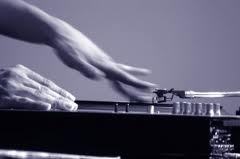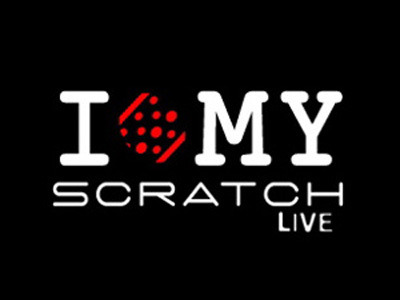-
-
-
Guests
- 4 December, 2012 in Opinions
From Turntablism to Controllerism
Originally written on November 29th, 2009 by DJ Blak Majik. Links updated for context:

As a professional DJ, I feel that it is important to not simply practice and stay proficient at what you do, but to stay up on the new technologies and techniques that ultimately will give us new ways to think about our art. Turntablism has been around for roughly 30 years, and was virtually unchanged from the time Grand Wizard Theodore stumbled across that weird-but-cool scratching sound. The standard equipment of that day was still the same old set-up of Technics SL-1200 turntables and a small club mixer. DJs have become more proficient at the techniques but until the equipment began to really change, the art itself maintained the same limitation: the crate of records you brought with you that night. That is until 2004.
At that time, Serato Scratch Live came to the market and began to change a lot of people’s perceptions on what makes a person a “true DJâ€. The debate began about “cheating†DJs, who were “taking a short cut†because they were using their laptops to play their mp3 files instead of crate digging for rare vinyl. Many people who had never tried SSL eventually got their chance to see it, and a lot of those arguments began to fade away as the program virtually became the U.S. club standard for a working DJ. This argument of what makes someone a “real DJ†has come up again and again as other new technologies have come to production, including CDJs, mixers with automatic BPM counters, and ultimately laptop DJing.
With the creation of Ableton Live and other programs designed for MIDI control, it is becoming more and more cost effective for a new aspiring DJ to bypass the turntables completely, and jump straight for a MIDI controller and software. Out of this concept of MIDI manipulation over fine tuning the ability to beat match, beat juggle, or apply the proper force to a record to execute a technique the emphasis is on creating the best “mashup†and software selection. Now all of the old techniques can be fully automated, and the art becomes song selection and the manipulation of sonic parameters throughout the mix. There is no denying now that DJing is now completely driven by the technology that the user have at their disposal, but what of the unfinished debates that spawned from vinyl DJs in the first place, the forgotten fight to justify the turntablist as a musician?

There is simply no black & white answer to any of these issues, but don’t be quick to point fingers at the new technologies and say they are killing our art. Vestax has created several products that allow traditional turntablists to explore new avenues that the controllerists are unable to easily adapt to…
For example, the Vestax QFO is a standalone turntablist dream straight from the mind of DJ Q-Bert. It is the first turntable of its kind with a 60% pitch control, internal 2 channel mixer with a 3-band EQ, auxiliary input, and built in crossfader. This development saves the turntablist from having to lug around an entire kit, when all they may need for a performance is an mp3 player and a few records.
The Vestax Controller One is marketed as “THE TURNTABLE INSTRUMENTâ€, and features buttons that allow the pitch to change from 8% to 60% on a full octave scale. What good is that you ask? Well with the creation of records like the Utility Phonograph Record (or UPR) series, synthesizers and other sounds are placed on individual endless tracks on the record. Each sound is recorded at a “C†note, so as you press each octave button, you can play an entire C-scale. See for yourself:
That’s just the tip of the iceberg, as advancements from this device (and it’s MIDI capability) have already brought fourth new turntable and mixer concepts. What about the everyday turntablists that don’t have $2,000 to spend on a single turntable?
DJ Sjam created the “Clocktave record“, taking some inspiration from DJ Q-bert’s “Y Recordâ€. By simply calculating out the amount of time it takes for a record to spin a full rotation around the table, you can easily calculate how to line up sounds in a realitive order. On the Clocktave, the 12 o’clock position will always be the lower end of solid tone increasing on an octave scale. By the time the record completes a full rotation, you are on the next sound, so you just as many creative options as with the controller one for song composition. Take a look at DJ Kypski’s example playing back a hip-hop classic on the Clocktave:
There are still many debates that will inevitably continue over who is more skillful, or who deserves respect as musician, the turntablist or the controllerist. While these issues are discussed, I argue only one thing: Both worlds came from one core, and whether you spin vinyl or manipulate sound itself the technology will still be ever changing. and we can’t blindly fight against the new innovations as they come to the spotlight. These technologies are being developed to simplify the process of making and playing music, and there will always be some sort of middle ground where both sides meet. I say experiment with some software if your wax is already covered in stickers. Learn how to manually beatmatch if you’ve mastered every parameter in Ableton Live. Learn how to use relative mode with timecode vinyl and see just how much faster it lets you move in a juggling set. Find some ways to incorporate scratching into your live routine and bring it to the next level. Just never forget that there’s always someone out there who is trying to stay a step ahead of you even as you read this. The foundation of a DJ battle still reigns true, you can’t win unless you are BETTER than the opponent at his best.
Vestax VCI-300 Practice Session from Grizu on Vimeo.
-
-
-
-
Mission Accomplished, Thanks and...
A Brief History of Controllerism.com
November 24th, 2015
by Moldover
I initially...
-
The Oval, The World’s First...
Support The Oval Kickstarter project here If you’re anything like me, then you were probably mesmerized...
-
The ACPAD, Wireless Control Surface for...
Berlin-based artist Robin Sukruso and ITT Bombay have developed a wireless control surface for acoustic...
-
Video Interview: The Robocaster and The...
Where does an idea for a new instrument like The Guitar Wing come from? How does it become a thing at a store...
-
DIY Jog Wheels
The jog wheels on many popular DJ controllers are some of the more complex input devices found on modern...
-
Meet the iRig 2
Exciting news on the instrumental front today – iRig 2 has been released. It’s the sequel/update...
-
Presets for Massive from Prime Loops
I am neck-deep in the music production for my forthcoming album Four Track, and just starting the process of...
-
-
Categories
- Events (17)
- Gear & Tools (91)
- Opinions (12)
- People & Adventures (143)
- Pic of the Week (21)
- Videos (7)

